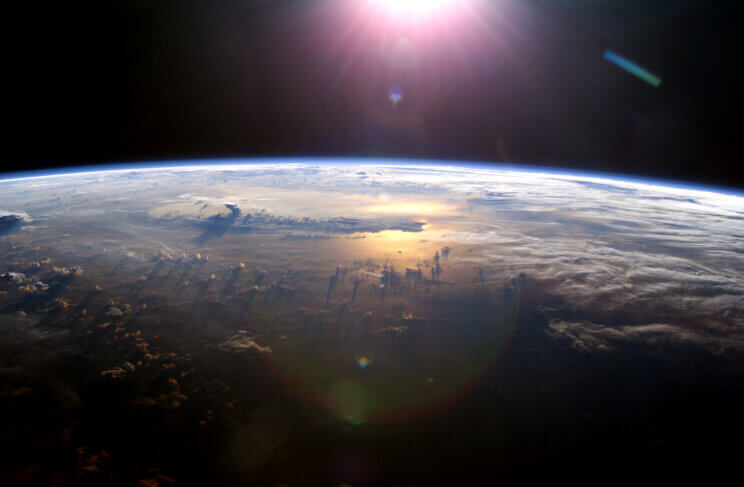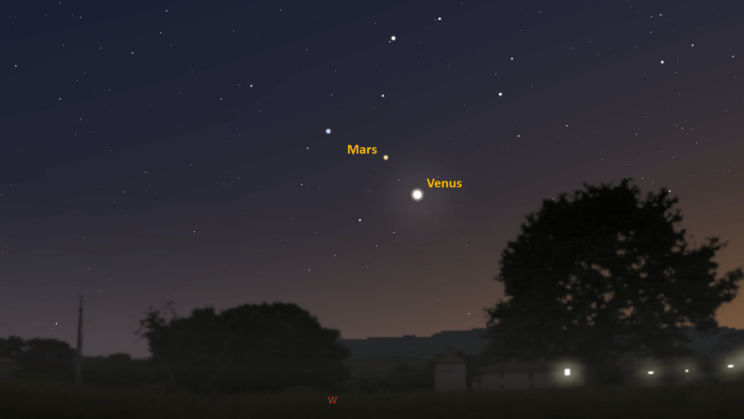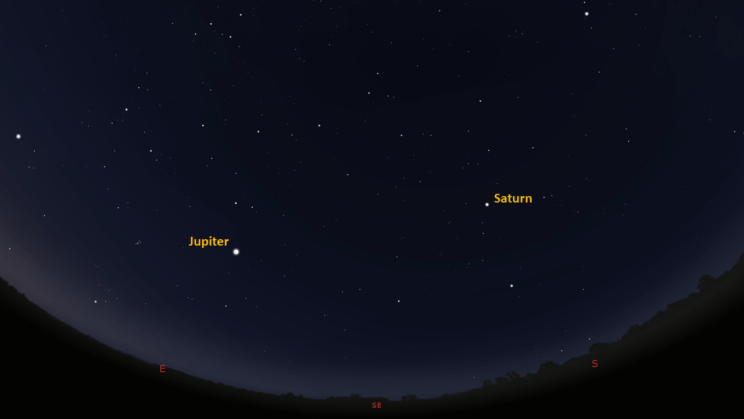This is the Saint Louis Science Center’s NIGHT SKY UPDATE for the week of Saturday, July 1, 2023.
Information updated weekly or as needed.
Times given as local St. Louis time which is Central Daylight Time (CDT). For definitions of terminology used in the night sky update, click the highlighted text. If relying on times posted in Universal Time (UT), St. louis is -5 hours when CDT.
Public Telescope Viewings
As part of the Saint Louis Science Center’s First Fridays, weather permitting, the St. Louis Astronomical Society and the Science Center will set up a number of telescopes outdoors and be on-hand to answer your questions. Telescope viewing begins once it is dark. Regardless of the weather on August 4 , join us indoors in our planetarium theater for “The Sky Tonight”. Showtime is at 7 p.m. There is no First Friday event in July.
Observing Highlight of the Week

The Sun seen over the pacific Ocean in 2003. This image was taken by the Expedition 7 crew aboard ISS. Image credit: NASA.
This week the Moon reaches its full phase, Earth reaches aphelion and Venus starts to pull away from Mars.
July’s full moon occurs on July 3, 2023, at 6:39 a.m. The full moon in July is often called the Full Thunder Moon due to the common occurrence of thunderstorms. While these kinds of names are not important today, they are a reminder of how the consistency of the lunar cycle was once used to track the passage of time. Our modern calendar is now solar based, but we can still find a connection to when lunar cycles were part of the calendar. Many traditions around the world are determined by moon phase. Calendars that still incorporate the Moon are called lunisolar calendars.
On July 6, 2023, the Earth will reach aphelion. This is when Earth is farthest from the Sun in its orbit. The nearest point is called perihelion which occurs in January. Next year the date of perihelion is January 2, 2023. The difference in distance between Earth and the Sun varies from roughly 91.4 million miles to 94.5 million miles. These near and far points in an object’s orbit are called apsides. They are the result of orbits being elliptical instead of circles. The Moon’s apsides are called apogee (far) and perigee (near). One cycle of lunar apsides is called an anomalistic month.
Lastly, July 1, 2023, was when Mars and Venus appeared nearest to one another. After this date, Venus’s motion will quickly outpace Mars. Venus will rapidly approach the Sun this month, eventually disappearing into the Sun glare by August. While our views of Venus get shorter each day, Venus will continue to become brighter until July 9, 2023. Pointing binoculars at Venus will reveal it is exhibiting crescent phases as it approaches inferior conjunction on August 12, 2023.
The Sun and Moon

The Moon as seen from the International Space Station, on July 31, 2011.
Credit: NASA
Sunrise is at 5:40 a.m. on Friday, July 1 and sunset is at 8:29 p.m. providing us with nearly 15 hours of daylight. Even after sunset, light from the Sun will dimly illuminate our sky for roughly 2 hours. This period is called twilight, which ends around 10:27 p.m. this week. For those with a sundial, local noon occurs around 1:04 p.m. this week.
| Day | Sunrise | Sunset | ||||||||||
|---|---|---|---|---|---|---|---|---|---|---|---|---|
| 1-Jul | 5:40 a.m. | 8:29 p.m. | ||||||||||
| 2-Jul | 5:40 a.m. | 8:29 p.m. | ||||||||||
| 3-Jul | 5:41 a.m. | 8:29 p.m. | ||||||||||
| 4-Jul | 5:41 a.m. | 8:29 p.m. | ||||||||||
| 5-Jul | 5:42 a.m. | 8:29 p.m. | ||||||||||
| 6-Jul | 5:42 a.m. | 8:28 p.m. | ||||||||||
| 7-Jul | 5:43 a.m. | 8:28 p.m. | ||||||||||
| 8-Jul | 5:44 a.m. | 8:28 p.m. | ||||||||||
| 9-Jul | 5:44 a.m. | 8:27 p.m. |
Moon
Moonrise for Saturday, July 1 is at 7:11 p.m. and moonset occurs at 4:19 a.m. on the following day. On Saturday, July 24, the Moon will exhibit a waxing gibbous phase with 97% disk illumination. Full moon occurs on July 3, 2023, at 6:39 a.m.
International Space Station (ISS) Observing

There are several visible passes of ISS from St. Louis for the week of July 1. They occur during morning hours for most of the week but transition to late evening and morning passes by July 9. The best passes for this week are listed below. Use the table below for information about these passes.
Catch ISS from St. Louis starting Saturday, July 1
| Date | Starts | Max. altitude | Ends | |||||||
|---|---|---|---|---|---|---|---|---|---|---|
| Time | Alt. | Az. | Time | Alt. | Az. | Time | Alt. | Az. | ||
| 02 Jul | -1.5 | 3:11:34 | 17 | NW | 3:12:33 | 20 | NNW | 3:15:05 | 10 | NNE |
| 03 Jul | -1.6 | 2:24:08 | 26 | N | 2:24:08 | 26 | N | 2:26:23 | 10 | NNE |
| 09 Jul | -1.3 | 23:52:46 | 22 | NW | 23:53:18 | 23 | NNW | 23:56:02 | 10 | NNE |
Magnitude (Mag): The Measure of brightness for a celestial object. The lower the value is, the brighter the object will be.
Altitude (Alt): The angle of a celestial object measured upwards from the observer’s horizon.
Azimuth (Az): The direction of a celestial object, measured clockwise from an observer’s location with north being 0°, east being 90°, south being 180° and west being 270°.
For information about ISS flyovers and other visible satellites, visit www.heavens-above.com
Detailed information regarding all unmanned exploration of our universe, missions past, present, and planned, can be found at Jet Propulsion Laboratories:
The Visible Planets

Looking west at 9:20 p.m. on July 2, 2023. Credit: Stellarium, EG

Looking Southeast at 4:30 a.m. on July 3, 2023. Credit: Stellarium, EG
This week, four naked eye planets will be visible. Venus and Mars are found in the west after sunset. Saturn and Jupiter are visible in the southeast and east before sunrise.
Venus
Venus is well into its current evening apparition. Venus will be a bright target in the west after sunset until August 2023 when it approaches inferior conjunction. This week, look for Venus in the west about 20 minutes after sunset. Venus sets at 10:44 p.m.
Mars
Mars now rises before sunset, becoming visible once it is dark. Look for it high in the west about 30 minutes after sunset. Mars sets at 10:58 p.m.
Jupiter
Jupiter is starting another apparition. Jupiter rises at 2:05 a.m. About one hour after Jupiter rises, it should be easy to spot. Jupiter will rise about 20 minutes earlier each week.
Saturn
Saturn rises at 11:32 p.m. Start looking for Saturn about 30 minutes after it rises. If you have lots of trees or buildings, you may have to wait an hour or so after it rises before it will be visible.
James S. McDonnell Planetarium
Night Sky Update: July 1-9, 2023






